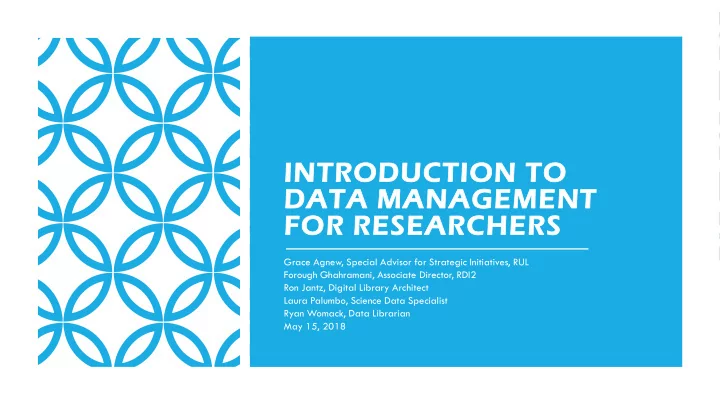

INTRODUCTION TO DATA MANAGEMENT FOR RESEARCHERS Grace Agnew, Special Advisor for Strategic Initiatives, RUL Forough Ghahramani, Associate Director, RDI2 Ron Jantz, Digital Library Architect Laura Palumbo, Science Data Specialist Ryan Womack, Data Librarian May 15, 2018
Organize your work Preserve for future reuse WHY DATA Impact MANAGEMENT? Credibility Future collaborators and your future self will need guidance on how to use the data you create today.
Some basic practices: Keep raw data pristine and separate from any working data Document your variables and data collection as you work Write down anything you yourself would forget when YOUR DATA revisiting the project 3 years later in response to a query That will be the same thing other users need too! Don’t work in Excel [if you can] or other manual editing environment You should write down all your steps if you are doing this Better to use code or an environment that will at least record your steps
FILE ORGANIZATION AND NAMING • Adopt a file naming convention that is structured and meaningful to you • Date, location, method, subject • All can be encoded into file name so that file is self-explanatory • File directory structure should also be logical and well-thought out • Separate raw data, modified data, code, documentation, other material • The larger the project, the greater the benefits of planning for organization and communicating the plan to all project participants
Readme Codebook DOCUMENTATION What do others need to use your data? Document early and often!
Rule of 3 => 2 onsite 1 offsite Dropbox is not backup, it is sync! Consider Future File Usability – Open Formats STORAGE AND BACKUP
OSF Dataverse OpenICPSR DISTRIBUTION Zenodo AND SHARING Opensciencedatacloud Re3data Disciplinary repositories like OOI and PDB And Open Data Licensing
Providing Access to Interdisciplinary Research Finding and Using Data – Most Important Major Virtual Data Collaboratory Goals • Who created the data, methodology, and time frame. • Provide researchers, educators, and entrepreneurs from • Salient aspects of the data and how can it be used. across a broad range of disciplines and scientific • Understanding how the data was collected and analyzed. domains seamless access to data and tools. • Determining the credibility of the data • Collaborators may want to limit access. • Enable researchers to develop and apply advanced • Concerns about reuse and whether users will understand the data management and analysis tools for high impact context. scientific applications. Finding Collaborators • Train the next generation of researchers with deep disciplinary expertise and a high degree of competence • Informal groups in leveraging data, infrastructure, and tools. • Researchers who have received grants in similar areas. • Conference networking – smaller conferences are best! • Analysis of citations to find the “gate - keepers” of the field VDC development is supported by a major in question. NSF grant and is a collaboration between Penn State, Rutgers, and Temple.
Standards such as DOI and ORCID enable identification and reuse Literate Programming REPRODUCIBILITY Github AND COLLABORATION Jupyter Rpubs
WHAT FORCES AFFECT INTERDISCIPLINARY RESEARCH? A DIALOG WITH RESEARCHERS What is your primary area of research and what are the most important disciplines outside of your primary area? Describe your approach to doing interdisciplinary research. How do you locate a person to get more information? How do you find a resource in another discipline? How do you determine if the information will be useful and credible? In locating an number of results, how do you select the most useful? 10
WHAT FORCES AFFECT INTERDISCIPLINARY RESEARCH? A DIALOG WITH RESEARCHERS How do you initiate a search and what are the most important keywords? What communities of collaboration are the most important for you? What are the most important tools that you use in your research? What are the obstacles that prevent you from carrying out your research? What are your suggestions for tools and resources that would improve your research? 11
THE ROUNDWORM (959 CELLS AND 302 NEURONS) Exploring and Simulating Virtual Life (See openworm.org) Research disciplines: biologists, computer scientists, histologists, mathematicians, molecular geneticists, neuroscientists 12
Recommend
More recommend